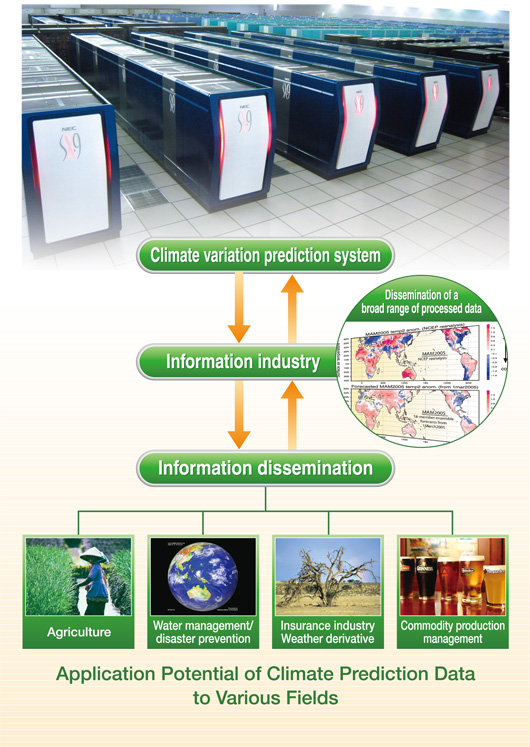Prediction of Climate Variations and its Application in the Southern African Region

The Application Laboratory is engaged in research development to apply or utilize scientific knowledge obtained by our world-leading investigations in climate variations such as the ones on Indian Ocean Dipole and El Nino. Practical applications include areas such as agriculture and water management. Prediction outputs are used not only for Japan but also for administrative and industrial activities throughout the world, in regions facing poor environmental prospects against the effects of climate variations. Applying climate variation prediction to the real world was adopted as a resolution statement at the Third World Climate Conference (held in Geneva in August 2009) and has since become a theme around the globe. The conference determined to create the IPCC (Intergovernmental Panel on Climate Change) reports in the past. These current global movements are aligned with the directions and goals of the Application Lab. The issues relating to such fields as the earth environment, energy and disaster prevention certainly need the climate variation information and they are, like climate variations themselves, of global nature that cannot be tackled by a single country but must be addressed jointly as common issues for the global community. "The JST-JICA Science and Technology Research Partnership for Sustainable Development Program“ entails promotion of international joint research targeting global issues and envisages future utilization of research outcomes based on the needs of developing countries. Implemented through collaboration with Official Development Assistance (ODA), the aim of the program is to acquire new knowledge leading to resolution of global issues and advancement of science and technology (an extract passage from http://www.jst.go.jp/global/english/index.html).
” The Application Lab’sproposal, “Prediction of Climate Variations and its Application in the Southern African Region” has been adopted as one of the research projects. This project, focused on South Africa, promotes a distinct climate variation prediction with research aimed at development of a model to predict climate variation specifically for the area. Weather /climate variation prediction is expected to extend down to the regional or local level, such as for Cape Town area or the Limpopo area. Research development in association with local researchers will utilize the Earth Simulator to produce an advanced model. The project will acquire detailed observation data with the cooperation of local agricultural experiment stations, with the aim of improving the prediction accuracy by using these data as initial values or validated data for the prediction model. The results of climate variation prediction will be distributed widely in future to local residents, agriculture-related entities, and others through cellphone and Internet connections. Cooperation with University of Pretoria and University of Cape Town is also planned. In addition to collaborative academic research, we are actively planning to assist human resources development through a series of lectures for students and mutual dispatch of scientists.
The production system in Southern Africa highly depends on natural variability and quite susceptible to climate variability risk. The purpose of this project is to find mechanisms working in initiation and variability of climate such as subtropical dipole mode, whose occurrence largely impacts on South African climate, and to use those results to enhance continuous development of southern African society. Specifically, we will perform ensemble forecast experiments using a state-of-the-art global air-sea coupled model, and predict natural variability of climate a few months or even a few years in advance. The forecast results from the global model will be utilized to drive a regional model to estimate impacts of large scale climate on local weather and to construct early disaster prevention system for southern Africa. Simultaneously, simulation results are examined and compared with observations to verify or improve the forecast systems, to investigate predictability of climate modes and to improve the numerical models themselves by developing rain parameterization schemes for example.
